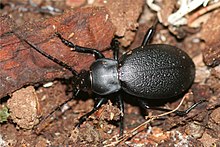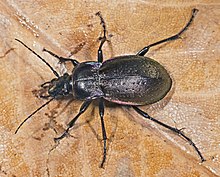Real ground beetles
| Real ground beetles | ||||||||||||
|---|---|---|---|---|---|---|---|---|---|---|---|---|

Blue-violet forest beetle ( Carabus problematicus ) |
||||||||||||
| Systematics | ||||||||||||
|
||||||||||||
| Scientific name | ||||||||||||
| Carabus | ||||||||||||
| Linnaeus , 1758 |
The real ground beetles or large ground beetles ( Carabus ) represent a genus within the ground beetles (Carabidae). As a rule, they include relatively large species, such as the up to 40 millimeter long leather ground beetle ( Carabus coriaceus ), the largest European species of the genus. About 100 species of this group live in Europe, 33 of them in Central Europe; over 850 species can be found worldwide.
features
Provide large beetles apart from members of the genus Procerus such as the giant beetles ( Procerus gigas ), in addition to the dolls robbers ( Calosoma ), sand beetles ( Cicindela ) and lesser known genera some the major types of beetles. In the case of European species, the range extends from around 13 millimeters for the blue beetle ( Carabus nitens ) to 40 millimeters for the leather beetle, tropical species can be up to 70 millimeters long. Like all ground beetles, they have five-limbed feet ( tarsi ) on all three pairs of legs as well as the eleven-limbed antennae that are positioned under a specially designed side edge of the forehead. In addition, the breast plates of the three thorax segments are firmly fused together. From the outside you can usually only see a fine line. The mostly smaller males can be recognized by the widened forelegs.
The cover wings (elytres) are designed differently and can have both a light grain and longitudinal ribs. Often there are rows of dots and chains from depressions or elevations in the sculpture. In many species the wings are fused at the seam . They often lack a second pair of wings. In addition, the flight muscles can be completely or partially reduced. The mouthparts are usually strong and can vary depending on the diet.
The larvae of large ground beetles can also have very different structures. The spectrum ranges, depending on the habitat and the way of life, from slim, parallel-sided to broad isle-like types.
distribution
The real ground beetles are widespread in the Palearctic and Nearctic and can be found in a wide variety of terrestrial habitats. Many species are endemic or can be found in very special habitats. Others, as generalists, have a very wide distribution area.
Way of life

Most species of ground beetle are nocturnal. Furthermore, all species are predatory and hunt down insects and other arthropods, as well as snails and earthworms. Some species are also diurnal and hunt accordingly during the day. All Carabus species are adapted to life on the ground. A large part, especially of the large species, is no longer able to fly due to the reduction of the hind wings and the flight muscles as well as the fused cover wings.
Large ground beetles have also developed a defense system against predators, especially birds and insectivorous mammals, by being able to release digestive secretions from the mouth and other defensive secretions from the anal glands.
Danger



Many species of large ground beetle are dependent on very special habitats and living conditions. Due to the increasing destruction of natural ecosystems and biotopes, these extremely adapted species have in some cases been reduced in their occurrence to such an extent that they are now considered highly endangered and are accordingly listed on the Red List . The large species such as the Carabus species, which are also most noticeable to hikers, are particularly affected . Since laypeople cannot be expected to be able to distinguish all species, all species of ground beetles in Germany have been placed under the provisions of the Federal Species Protection Ordinance.
species
The large ground beetles are represented worldwide with over 850 species, whereby new species are regularly described. Of these 100 species can be found in Europe, 33 species of the genus Carabus live in Central Europe . The following list represents a selection of species:
- Alpine ground beetle ( Carabus alpestris ) storm , 1814
- Carabus arcadicus
- Hill ground beetle ( Carabus arcensis ) autumn , 1784
- Gold beetle or goldsmith ( Carabus auratus ) Linnaeus , 1761
- Shiny gold ground beetle ( Carabus auronitens ) Fabricius , 1792
- Common wart or field ground beetle ( Carabus cancellatus ) Illiger , 1798
- Carinthian ground beetle ( Carabus carinthiacus ) storm , 1815
- Shore ground beetle ( Carabus clatratus ) Linnaeus , 1761
- Short Corrugated or convex beetles ( carabus convexus ) Fabricius , 1775
- Leather beetle ( Carabus coriaceus ) Linnaeus , 1758
- Creutzers ground beetle ( Carabus creutzeri ) Fabricius , 1801
- Fabricius ground beetle ( Carabus fabricii ) Duftschmid , 1812
- Carabus galicianus Gory, 1839
- Germars ground beetle ( Carabus germarii ) Storm , 1815
- Smooth ground beetle ( Carabus glabratus ) Paykull , 1790
- Grained ground beetle or grained ground beetle ( Carabus granulatus ) Linnaeus , 1758
- Carabus hispanus Fabricius , 1787
- Gold pit ground beetle ( Carabus hortensis ) Linnaeus , 1758
- Dark blue ground beetle or blue ground beetle ( Carabus intricatus ) Linnaeus , 1761
- Ravine forest ground beetle ( Carabus irregularis ) Fabricius , 1792
- Linne's ground beetle ( Carabus linnaei ) carapace , 1812
- Bog ground beetle ( Carabus menetriesi ) bumblebee , 1827
- Carabus monilis Fabricius , 1792
- Grouse beetle ( Carabus nemoralis ) OFMüller , 1764
- Wood beetle ( Carabus nitens ) Linnaeus , 1758
- Black pit beetle ( Carabus nodulosus ) Creutzer , 1799
- Blue-violet forest beetle ( Carabus problematicus ) Autumn 1786
- Carabus rutilans Dejean 1826
- Scheidler's ground beetle ( Carabus scheidleri ) tank , 1799
- Mountain forest ground beetle ( Carabus sylvestris ) shell , 1793
- Cusp-striped ground beetle ( Carabus ullrichii ) Germar , 1824
- Pit beetle ( Carabus variolosus ) Fabricius , 1787
- Violet ground beetle or gold ridge ( Carabus violaceus ) Linnaeus , 1758
Individual evidence
- ↑ While carabus (Latin), so widely handed down, only means "crab", Aristotle also uses κάραβος as (a kind) "wooden beetle" (dictionaries: Pape 1880, Georges 1913).
- ↑ Jiři Zahradník, Irmgard Jung, Dieter Jung et al .: Käfer Central and Northwest Europe , Parey Berlin 1985, ISBN 3-490-27118-1
- ↑ Carabus at Fauna Europaea
literature
- KW Harde and F. Severa: The Kosmos Käferführer . Franckh-Kosmos Verlag, Stuttgart 2000, ISBN 3-440-06959-1 .
- Ekkehard Wachmann , Ralph Platen, Dieter Barndt: Ground beetles - observation, way of life . Naturbuch Verlag, Augsburg 1995, ISBN 3-89440-125-7 .
further reading
- CH Lindroth: The Carabidae (Coleoptera) of Fennoscandia and Denmark. Scandinavian Science Press Ltd., Leiden 1985, ISBN 90-04-07727-8
- T. Deuve: Illustrated Catalog of the Genus Carabus of the World. Pensoft Publishers 2004
- Edmund Reitter : Fauna Germanica - The beetles of the German Empire. Volume 1, KG Lutz, Stuttgart 1908
- Edmund Reitter : Fauna Germanica. The beetles of the German Reich (= digital library . 134). Neusatz and facsimile of the 5-volume edition Stuttgart 1908 to 1916. Directmedia Publishing, Berlin 2006, ISBN 3-89853-534-7 .
- Helmut Schütze , Frank Kleinfeld . The caraben forms of China with a detailed list of their locations. Supplement Taxonomic Catalog of Chinese Carabids. Schwanfeld 1995, ISSN 0945-1889
